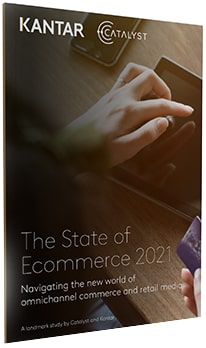Consumer Preferences & Changing Demographics
Online grocery was here well before the pandemic, but not as heavily adopted. As COVID-19 forced consumers to explore and use online grocery platforms more regularly and intensely, they simultaneously fell in love with its convenience, which will likely drive long-term online grocery adoption.
Pandemic or not, consumers have embraced the ability to stay at home and get other things done without having to physically go to a grocery store. Shoppers have become accustomed to the quick delivery and instant gratification of online grocery, a benefit they’ll continue to seek post-pandemic. As an Instacart user myself, I love that I can place an order at 2:00PM in the afternoon and have delivery guaranteed within three hours.
And it’s not just younger, digital savvy consumers who are embracing online grocery and its convenience. Online grocery has been widely adopted by consumers of all ages, including older demographics who’ve not historically shopped online.
According to Instacart’s “Beyond the Cart: A Year of Essential Insights,” there was a 9% increase in the number of seniors using the platform between Q1 2020 and Q4 2020. To aid platform adoption across older demographics, Instacart has launched their Senior Support Service, which is quickly growing by 1,000 seniors per day.
On top of that, many seniors reap the benefits of online grocery indirectly. For example, even before the pandemic caregivers have been relying on ecommerce to grocery shop for senior customers. According to a 2019 AARP report, 83% of caregivers reported shopping online for their loved ones.
Platform Improvements Fueling Online Grocery’s Longevity
Leading online grocery platforms like Instacart, Walmart, and Amazon are keeping consumers coming back for more. They are consistently updating their platforms and offerings to keep customers happy and attract new ones, contributing to the longevity of online grocery. For example:
Instacart
Instacart has been regularly adding new retailers to its network. Now, the beauty of Instacart is that you can shop at multiple stores without having to leave your couch. The other day I was able to place orders from Stop & Shop, Petco, and Wines & More all through the Instacart app. These enhancements convert new users to Instacart, increasing the chances they’ll become loyal online grocery shoppers through the platform.
In May, Instacart also announced the launch of “Priority Delivery.” The service, which was launched in select metro areas in the U.S. and Canada, offers deliveries as fast as 30-minutes. This reduced delivery window could attached customers who would normally make a “quick trip” to a store for immediate needs or small orders.
Walmart
Walmart is also working to reduce delivery times. In 2020, Walmart Grocery added Express Delivery so that you can get your order within two hours. The service promises the same low-cost prices online as in-store and consumers can use express delivery on just about any product.
According to TechCrunch, Walmart reports that the Express service can reach nearly 70% of the U.S. population; however, it’s aiming to expand its reach even further through the August 2021 launch of GoLocal. GoLocal is a B2B service that will allow merchants to use Walmart’s last-mile delivery capabilities and infrastructure to get orders to consumers. Improvements like these could increase platform adoption by making online grocery and quick delivery times available to more customers.
Amazon
Amazon is the world’s ecommerce juggernaut. That scale and power enables them to offer a wide-range of online grocery services that satisfy diverse customer needs and desires.
For example, Amazon’s acquisition of Whole Foods has enabled them to offer delivery of Whole Foods items for Prime members living in certain areas. Whole Foods’ organic and premium products are now only a click away. Amazon Fresh offers delivery of some Whole Foods 365 products, but also offers most products you’d find at a brick and mortar grocery store. Amazon Fresh is available in select cities across the U.S. And, let’s not forget good old Amazon Prime. Consumers can order non-perishable grocery items through their Amazon accounts.
Lastly, Amazon has also rolled out Launchpad. This area of the Amazon site showcases start-up brands and products and includes a dedicated grocery section. It’s a great way to explore new non-perishable products from up-and-coming companies without having to make a trip to boutique or specialty grocery store.
With all of these options and constant innovation, it’s not surprising that consumers continue to turn to Amazon for their online grocery needs.







